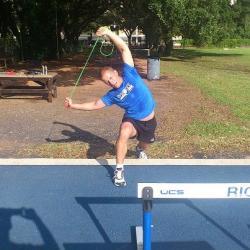How to get fit for tennis
1 CommentOn Monday we looked at the demands of tennis, now we look at putting that into practice. With a nation inspired by British hopes at Wimbledon, start getting fit now.
How can I get fit for tennis?
Start with flexibility and build from there. Every player needs to have a foundation of mobility and flexibility to build upwards from. This needs to be worked on regularly, not something that is done once a week or when you feel tight.
At Excelsior we encourage our athletes to do a series of exercises called 5×5’s, these are 5 exercises to be done daily for a minute each, these work on control, technique and flexibility.

Flexibility can be worked on during warm ups with exercises like multi-directional lunges, this exercise gradually puts the body into full extension stretching muscles and nerves prior to playing.
Getting into the habit of a daily stretch routine is a great way to improve flexibility, this needs to take into consideration exercises that you as an athlete feel working not just one you have been told to do.
Working out three routines that can be alternated, can alleviate the monotony of one routine
Fit for 5 sets?
Training endurance directly is not always simple due to time constraints and should therefore be done during a tennis session if possible. From looking at the demands and research I would suggest a mixture of interval training and longer distance training.
In a session shorter distance sprints can be done during an extended warm up or within drills themselves. Longer distances can be done when the athlete has time and for example going on a 5 mile bike ride.
One problem with common training methods for the aerobic system is that it can result in injuries. Athletes going on long slow runs use poor form compared to if they trained over shorter distances, swimming and cycling would be better methods as they reduce impact on joints. injuries.
(For running technique tips see here)
Speed/ Agility
Before working on speed and agility you need to make sure you can brake and control the movements, this is where a base level of control and co-ordination is required. (More information on different surface requirements here)
The majority of tennis sessions will involve a large amount of agility, if during conditioning sessions this is worked on solely for long periods of time, there is a good chance the body will not be able to recover and see any adaptations before injury occurs.
Another time this can be worked on is during warm ups, this does not mean repeated sprints but looking at first steps and braking.
Over the last 4 months the cricketers I work with have used bodyweight exercises to strengthen and braking drills to improve co-ordination. They have all now met the ECB’s criteria on the yoyo test, this is due to being more efficient and stronger when turning.
Strength
To make it to the top in any sport you need to practice, this is impossible if you are injured! A strength programme should help build control and technique to withstand the rigors of intensive training.
All athletes need to improve their strength, this does not mean looking at how much you lift in comparison to your bodyweight, it means improving strength that is relevant to your sport. Tennis for example is a game where you lunge with varying degrees of extension and control.
By improving areas such as the BIG HOUSE and legs, you will be able to not only control a lunge better but also at greater speed enabling you to return to a ready position quicker.
When many people try to improve these they use resistance machines in their gyms, these were designed to reduce the need for stabilisation during a movement and are therefore not ideal. Below is an example of exercises that take away the need for machines and are more athletic.
| Muscle | Machine Exercise | Preferred option 1 | Preferred option 2 |
| Quadriceps | Leg Extension | Squat | Single leg squat |
| Hamstrings | Leg Flexion | Single leg bridge | Deadlift |
Summary
- Tennis has evolved over the years and is now a more powerful game, due to different technology and athletes realising conditioning is a vital component of their training.
- Your programme needs to have a long term plan not just work on a quick fix to one specific area, unless you are in post injury rehab.
- Building a strong foundation and making small progress will lead you to being an overall better athlete.
- Starting a training programme can be difficult and you need to get into a routine.
- It is like pushing a heavy object, getting the object moving takes a lot of effort but as momentum builds its becomes easier to continue the momentum.
For a comprehensive training programme that fits into your schedule, try our Sports Training System
Duncan Buckmaster

